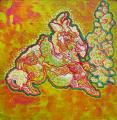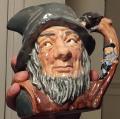
DMT-Nexus member
Posts: 690 Joined: 14-Mar-2010 Last visit: 16-Feb-2024 Location: sur la mer
|
did I spell squeamish right? Anyway, saw this today, and ... well, you'll understand. The full source report in pdf format can be accessed by academic professionals by following the links in the Journal Of Archaeological Sciences report below. https://www.natureworldn...a-bodies-during-inca.htmhttps://www.sciencedirec...s/pii/S2352409X22000785#! Have a nice day everybody, and give you kids a hug. WHOA!
|
|
|
|
|

DMT-Nexus member
Posts: 1045 Joined: 12-Mar-2010 Last visit: 11-Jun-2024 Location: Urf
|
No offense, but who wrote this? "These plants affect an individual's perception of emotions, space, and time, as per the Amherst College in Massachusetts, United States." Cocaine a) isn't hallucinogenic and b) it wasn't cocaine--they were chewing coca leaves. Sure, it's a good theory that they were given coca to help numb the pain, but really... this article needs to be way clearer than it is for me to trust it. From the unspoken
Grows the once broken
|
|
|

❤️🔥
 
Posts: 3648 Joined: 11-Mar-2017 Last visit: 15-Dec-2025 Location: 🌎
|
I think they mean cocaine the molecule was found in the analysis of fingernails/hair (not that a powdered drug extract was in use). The suggestion that aya and coca leaf were used for their anesthetic effects seems like a projection of western medicine. Not clear if that intent had anything to do with the Inca ritual. Child sacrifice is something I don't understand 😔
|
|
|

DMT-Nexus member
Posts: 847 Joined: 15-Aug-2020 Last visit: 17-Feb-2024
|
Having encountered briefly some of the darker tones of the hyperspace, I can easily image that some dark entities can lure people in power to do something as brutal as human sacrifice perhaps just in order to fool them. That history alone should serve as a reminder that psychedelics alone are not the highway to happiness but can actually lead to bad things if those who take them are not well-versed in their moral integrity. Believe not every spirit.
|
|
|

Dreamoar

Posts: 4711 Joined: 10-Sep-2009 Last visit: 18-Dec-2025 Location: Rocky mountain high
|
Socha, Dagmara M., et al. "Ritual drug use during Inca human sacrifices on Ampato mountain (Peru): Results of a toxicological analysis." Journal of Archaeological Science: Reports 43 (2022): 103415. Quote:Hallucinogenic plants and psychotropic stimulants performed an important role in the beliefs, rituals and divination practices in the ancient Andes. The aim of this article is to present the results of toxicological studies of two individuals immolated over 500 years ago during a capacocha ritual on the mountain of Ampato mountain in southern Peru. The capacocha was one of the most significant ceremonies carried out in the Inca Empire. During the ritual, the Incas sacrificed children and young women who were supposed to be beautiful and unblemished. The hair and nails of two Ampato mummies were examined using LC-MS/MS for the presence of coca alkaloids and metabolites (cocaine, benzoylecgonine, cocaethylene), mescaline, tryptamine, harmaline and harmine. The results of the study show that during the last weeks of the victims’ lives, they chewed on coca leaves and were intoxicated by ayahuasca, a beverage made primarily from the Banisteriopsis caapi. In modern medicine, the properties of harmine led to the use of ayahuasca in the treatment of depression. Chroniclers mentioned the importance of the victims’ moods. The Incas may have consciously used the antidepressant properties of Banisteriopsis caapi to reduce the anxiety and depressive states of the victims.
|
|
|
DMT-Nexus member
Posts: 575 Joined: 03-May-2020 Last visit: 09-Aug-2025
|
The word victim might not be more than our wish to impose modern western criminality to the ceremonies. Many cultures considered being sacrificed a great honour. I don't know much, but I do know this. With a golden heart comes a rebel fist.
|
|
|

Boundary condition

Posts: 8617 Joined: 30-Aug-2008 Last visit: 24-Dec-2025 Location: square root of minus one
|
The Amherst college document was beyond basic! There's a link to the journal article in a similar recent thread, so it seems like a good idea to combine this discussion with the one there. They'll get merged in due course. Merged  “There is a way of manipulating matter and energy so as to produce what modern scientists call 'a field of force'. The field acts on the observer and puts him in a privileged position vis-à-vis the universe. From this position he has access to the realities which are ordinarily hidden from us by time and space, matter and energy. This is what we call the Great Work." ― Jacques Bergier, quoting Fulcanelli
|
|
|

Dreamoar

Posts: 4711 Joined: 10-Sep-2009 Last visit: 18-Dec-2025 Location: Rocky mountain high
|
Oh I totally missed that, yep I'll merge it in.
|
|
|
DMT-Nexus member
Posts: 21 Joined: 02-Oct-2021 Last visit: 24-Jan-2025
|
It says a lot about the mindset of the researchers that they assume the Aya was being used for its antidepressant effects. Assuming that priests performing human sacrifice were thinking in utilitarian terms, as opposed to darkly spiritual.
|
|
|

DMT-Nexus member
Posts: 340 Joined: 19-Nov-2018 Last visit: 18-Sep-2025
|
PolarisZ wrote:It says a lot about the mindset of the researchers that they assume the Aya was being used for its antidepressant effects. Assuming that priests performing human sacrifice were thinking in utilitarian terms, as opposed to darkly spiritual. Here's a quote from the main text that describes the precedent for their assumption a little (beyond MAOI use as an antidepressant). I would guess that it is also difficult to get speculations about dark spirituality etc. published. Quote:The information about using stimulants during rituals appears in the chronicles. According to Francisco de Avila (1966 [1598]), the Incas gave the children chicha so they would go happy to Viracocha (the Creator, a main deity of the Inca pantheon). Other chroniclers mentioned that alcohol was used to dull the victims’ senses and calm them down before death (Cobo, 1990 [1623]; Ramos, 1976 [1621]:81). The studies of the hair of the other capacocha victims from Cerro Esmeralda, Llullaillaco and Sara Sara revealed that the children and young women immolated during the rituals were chewing coca leaves during their last weeks (Besom, 2000, Wilson et al., 2013). An analysis of some of the mummies showed the presence of cocaethylene, which means that chewing coca leaves was combined with the drinking of alcohol (most probably chicha; Wilson et al., 2013). Quids of coca leaves were found inside the mouths of the older females found on Llullaillaco and Cerro Esmeralda (Besom, 2000, Wilson et al., 2013). I do think this is quite speculative though: Quote:Ogalde and his team (et al., 2009) suggest that the lianas of Banisteriopsis caapi could be used alone as medicine in Azapa Valley. The positive results for the infant imply a more therapeutic than vision inducing purpose. Harmine works as a MAOI and blocks the metabolism of serotonin and dopamine (Fábregas et al., 2010, Osório et al., 2015). The antidepressant action after drinking the decoction can last for a couple of weeks. They acknowledge the spiritual angle a little as well: Quote:The consumption of the hallucinogenic ayahuasca could have been related to the desire of communication between the victims and the spiritual world. _________________________________________________________________________________________________ Loveall wrote:Child sacrifice is something I don't understand 😔 I don't either, but I thought this was interesting: Quote:Nevertheless, the Ampato #3 individual had suffered from the malformation of the transverse foramen, which could have caused alterations in blood circulation and nerve damage (Fig. 3; Cai et al., 2018, Goray et al., 2005, Socha et al., 2021a, Socha et al., 2021b). An injury to this region causes blood circulation impairment, chronic headaches, hypoxia, loss of consciousness caused by abrupt movements of the head, partial paralysis, temporary blindness and vertigo (Cai et al., 2018, Sultana et al., 2020). According to the chroniclers, body malformation and congenital impairment of the victims could be desirable because it was interpreted as evidence of the interference of gods (Arriaga, 1968 [1621]: 214–215). I do recall a story about native americans putting children with birth defects, disabilities etc. into dedicated pits in the desert to die (presumably before they become more of a burden). The story I read or heard had them tying their horses and walking the kids a short distance to the pits because the stench of fear/death was too disturbing for the horses. This ritual is a little more ceremonious at least I suppose. I'm not implying all child sacrifices were disabled though.
|
|
|

❤️🔥
 
Posts: 3648 Joined: 11-Mar-2017 Last visit: 15-Dec-2025 Location: 🌎
|
I've also heard that the most beautiful, intelligent, and healthy children were chosen for sacrifices to honor the gods. Can't find the reference now. Doesn't make sense to me. I try to ground myself (mindset/beliefs) in the physical. What is healthy. Otherwise, it seems to me that mind and beliefs can wonder into bizzare territories. From this point of view, smoking cigarettes is a form is social insanity when it is seem as normal. Sedentary and stress inducing lifestyles too. High rates of suicide and mental health are not something to gloss over. Rates of heart disease off the charts. These things should be front and center in my opinion, but socially we seem to focus on other things, which to me seem less relevant.
|